Introduction
This research focused on the study of the use of different drying temperature variations in protecting active compounds on the peel of the aloe vera that was crushed, because the heating process such as drying in addition to affecting the chemical and biological processes in the material, also affects the number of active compounds contained there in. According to Narsih et al. 1 aloe vera peel contains many active compounds that have the ability as antioxidants to be sensitive, so the handling must be appropriate. The availability of active compounds on the peel of aloe vera contains compounds that are volatile and sensitive to heat, so that proper handling must be done such as temperature regulation and proper drying method in its crushing.
The use of drying temperature in a number of studies that have been conducted, concluded that it can affect the quantity and quality of the desired compound, so the preparation as a raw material is difficult to meet the standard criteria, therefore the drying temperature must be determined which can provide the maximum protective effect of the active compound. Pengseng et al. 2 concluded that the use of temperatures in the range of 25-90 oC did not cause antioxidant damage to raw material components and Rajkumar et al. 3 stated that the drying process with the addition of foaming agent would produce a product that has good quality. This is also supported by Kudra and Ratti 4 which states that drying with the addition of foaming agent can shorten the drying time. The problem to be investigated in this research is how to protect the maximum quantity and quality of active compounds on the peel of aloe vera to be applied to functional food products. The purpose of this study was to determine the quantity and quality of active compounds in aloe vera peel powder.
Materials and Method
Materials
Aloe vera (Aloe chinensis) used in harvested by farmers in Pontianak, West Kalimantan, Indonesia, with 8 months old and weight of 1 kg with the condition that it has a uniform green color on the top and bottom peel surfaces. Maltodextrin with DE 20 specifications was obtained from chemical stores in the city of Pontianak.
Sample Preparation
Aloe vera is sorted to remove mucus and other impurities, then washed with running water, blended by adding 1: 5 water the results obtained are then filtered. The filtrate is evaporated to remove water. Evaporation results added 15% maltodextrin and 0.1% Tween 80, homogenized with a mixer for 3 minutes. Samples were spread over aluminum foil and dried at 60,70 and 80oC for 6 hours. The dried aloe vera was milled and sievied using a 80- mesh sieve to obtain aloe vera powder.
Biochemical Assays
Volatile Compound Test
The Aloe vera (L.) peel powder were analyzed for phytocomponent using GC-MS QP2010S-Shimadzu under the following conditions: column used were Rtx-5MS, 30 m length and inner diameter of 0.25 mm and the initial column temperature was 40oC and final temperature was 260oC (5oC/min), while the injector temperature was 250oC with split mode injector and split ratio of 68 and pressure of 14.0 kPa. The flow rate was 1.3 ml/min and the flow within the column was 0.50 ml/min. The detector temperature was 3000C and using Helium as the gas carrier with EI (Electron Impact); and the samples volume injected was 1μl. Compounds were identified by comparing retention indices/comparing mass spectra of each compound with those of authentic samples and library.
Phenolate Compound Test
Aloe vera peel powder was analyzed with phenolic compounds using HPAD (High Performance Liquid Cromatography) Shimadzu under the following conditions: SPD 20-A UV Vis Detector Detector, Column Shim-pack VP ODS 5 μm 150 x 4.6 mm, Column temperature 25 °C, Mobile phase 0.1% TFA in acetonitrile. Mobile phase method Isocratic method, Flow rate 0.45 ml / min Wavelenght detector 280 nm and run time 25 minutes.
Cell Microstructure Test
The structure of Aloe vera peel powder produced was analyzed using SEM (Scan Electron Microscope) JSM T-100, JEOL, Japan. Samples were dehydrated by placing them in critical point drying equipment and then fastened with a special glue to the stub (samples holder). Samples were left to dry for ± 1 day. Samples were coated with pure gold or carbon for 1 h at a coating evaporator machine prior to being observed and their microscopic photos were taken by scanning electron microscope (SEM) machine.
Results and Discussion
Volatile Compounds
Volatile compounds detected at 60oC drying temperature within 6 hours Chromatogram GC-MS constituent of the identification results of the aloe vera powder which was dried at 60 oC for 6 hours is presented in Figure 1 and Table 1. In Figure 1 there are 21 constituent compounds identified in aloe vera peel powder crushed with maltodextrin at 60 oC within 6 hours and the constituent compounds are presented in Table 1.The compounds identified in aloe vera peel powder added with maltodextrin and dried at 60 oC within 6 hours include: α Pinene, Limonene, Mycerene, Benzylacetone, Carvone, Linalool, Mentone, Menthol, 7 Hydroxychromone, Anthracene, Conyferilalkohol, 9 Metylphenanthrene, 1 Anthrol, Anthranol, β-caryophyllene, β-Selinene, Aloesone, Aloesol, Dodecylbenzene, Chrysophanol, Thidecybenzene. Based on Figure 1 and Table 1, the most dominant compounds were Chrysophanol 9.49% at peak 20, Anthranol 7.96% at peak 14, Aloesone 6.85% at peak 17, Menthone 6.50% at peak 7 and 1 Anthrol 6.09% at peak 13. Generally, the compounds detected are monoterpenoid compounds which have antioxidant properties. This result is different from the research of Narsih et al. 1 which identified compounds in aloe vera peel powder which was dried at 60 oC for 6 hours with 10% maltodextrin concentration that obtained 11 compounds with 5 dominant compounds.
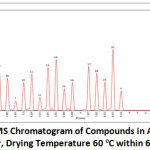 |
Figure 1: GC-MS Chromatogram of Compounds in Aloe Vera Peel Powder, Drying Temperature 60 oC within 6 Hours. |
Table 1: Volatile Components at Different Temperatures (60oC, 70oC, 80oC)
| Volatile Powder ComponentsTemperature 60oC | Volatile Powder ComponentsTemperature 70oC | Volatile Powder ComponentsTemperature 80oC | ||||
| Peak No. | Compound Names | Composition (%) | Compound Names | Composition (%) | Compound Names | Composition (%) |
| 1 | α Pinene | 3,22 | α Pinene | 2,32 | α Pinene | 3,01 |
| 2 | Limonene | 2,23 | Limonene | 2,47 | β-Pirene | 1,96 |
| 3 | Myrcene | 4,44 | Mycerene | 4,91 | Limonene | 2,08 |
| 4 | Benzylacetone | 5,34 | Benzylacetone | 5,91 | Myrcene | 4,14 |
| 5 | Carvone | 3,65 | Carvone | 4,04 | Benzylacetone | 4,98 |
| 6 | Linalool | 4,13 | Menthone | 7,19 | Carvone | 3,40 |
| 7 | Menthone | 6,50 | Menthol | 5,52 | Linalool | 3,80 |
| 8 | Menthol | 4,99 | 7 Hydroxychromone | 1,64 | α Terpineol | 2,78 |
| 9 | 7 Hydroxychromone | 1,48 | Anthracene | 4,80 | Menthone | 6,07 |
| 10 | Anthracene | 4,34 | Conyferilalkohol | 6,25 | Menthol | 4,60 |
| 11 | Conyferilalkohol | 5,65 | 9 Metylphenanthrene | 2,24 | Hydroxychromone7 | 1,30 |
| 12 | 9 Metylphenanthrene | 2,02 | 1 Anthrol | 7,40 | Anthracene | 4,05 |
| 13 | 1 Anthrol | 6,09 | Anthranol | 8,81 | Coniferylalcohol | 5,27 |
| 14 | Anthranol | 7,96 | β-caryophyllene | 3,74 | 9 Methylphenantherene | 1,89 |
| 15 | β-caryophyllene | 3,38 | Aloesone | 7,75 | 1 Anthrol | 6,24 |
| 16 | β-Selinene | 4,34 | Aloesol | 6,14 | Anthranol | 7,43 |
| 17 | Aloesone | 6,85 | Dodecylbenzene | 4,87 | β-Caryophyllene | 3,15 |
| 18 | Aloesol | 5,82 | Chysophanol | 10,49 | β-Selinene | 4,05 |
| 19 | Dodecylbenzene | 4,40 | Tridecylbenzene | 3,30 | Decylcyclohexane | 1,89 |
| 20 | Chrysophanol | 9,49 | – | – | ||
| 21 | Thidecybenzene | 2,98 | – | – | ||
Volatile Compounds Detected at 70oC Drying Temperature within 6 Hours
Chromatogram GC-MS of the constituent compounds resulting from identification of aloe vera shell powder dried at 70 oC for 6 hours is presented in Figure 2 and Table 1. In Figure 2 there are 19 constituent compounds identified in aloe vera peel powder crushed with maltodextrin at 70 oC within 6 hours and the constituent compounds are presented in Table 1. In the treatment of drying temperature of 70oC with 6 hours identified 19 compounds namely α Pinene, Limonene, Mycerene, Benzylacetone, Carvone, Menthone, Menthol, 7 Hydroxychromone, Anthracene, Conyferilalkohol, 9 Metylphenanthrene, 1 Anthrol, Anthranol, β-caryophyllene, Aloesone, Aloesol, Dodecylbenzene, Chysophanol, Tridecylbenzene. The dominant compounds were Chysophanol 10.49% at peak 18, Anthranol 8.81 peak 13, 1 Anthrol 7.40 peak 12, Menthone 7.19 peak 6 and Aloesol 6.14 peak 16. When compared with the same sample but drying treatments using different temperatures and times (Figure 1 and Table 1) then in Figure 2 and Table 2 there is a loss of 2 compounds namely Linalool and β-Selinene.
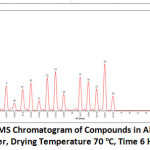 |
Figure 2: GC-MS Chromatogram of Compounds in Aloe Vera Peel Powder, Drying Temperature 70 oC, Time 6 Hours. |
Table 2: Components of Phenol Compounds at Different Temperature (60oC,70oC,80oC)
| Components of Phenol PowderTemperature 60oC | Components of Phenol PowderTemperature 70oC | Components of Phenol PowderTemperature 80oC | ||||
| Peak No | CompoundNames | Results (µg/g) | Compound Names | Results (µg/g) | Compounds Names | Results (µg/g) |
| 1 | Catechol | 350,55 | Catechol | 316,86 | Catechol | 414,30 |
| 2 | Pyrogallol | 513,44 | Pyrogallol | 464,12 | Pyrogallol | 606,76 |
| 3 | Salicylic | 125,24 | Salicylic | 113,16 | Salicylic | 148,09 |
| 4 | Protocatechuic acid | 422,11 | Protocatechuic acid | 381,54 | Protocatechuic acid | 498,88 |
| 5 | β-Coumaric acid | 605,43 | β-Coumaric acid | 547,33 | β-Coumaric acid | 715,37 |
| 6 | Gallic acid | 528,56 | Gallic acid | 477,82 | Gallic acid | 624,57 |
| 7 | Caffeic acid | 734,49 | Caffeic acid | 664,00 | Caffeic acid | 867,85 |
| 8 | Ferrulic acid | 365,12 | Ferrulic acid | 330,04 | Ferrulic acid | 431,49 |
| 9 | Cholorogenic acid | 488,26 | Cholorogenic acid | 441,38 | Cholorogenic acid | 576,96 |
Linalool and linalyl acetate are monoterpene compounds which are the main volatile components of essential oils from several aromatic species and according to Peana and Moretti, 5 have pharmacological activities and research conclusions that linalool and linalyl acetate have anti-inflammatory activity. The next compound is β-Selinene which is a group of sesqueterpene compounds.
Volatile Compounds Detected at 80oC Drying Temperature within 6 Hours
Chromatogram GC-MS of the constituent compounds resulting from identification of aloe vera peel powder dried at 80 oC for 6 hours is presented in Figure 3 and Table 1. In Figure 3 there are 19 constituent compounds identified in the Aloe vera peel powder which are crushed with maltodextrin at 80 oC within 6 hours and the constituent compounds are presented in Table 1. In the drying treatment temperature of 80 oC with 6 hours identified 19 compounds namely: α Pinene, β-Pirene, Limonene, Myrcene, Benzylacetone, Carvone, Linalool, α Terpineol, Menthone, Menthol, 7-Hydroxychromone, Anthracene, Coniferylalcohol, 9 Methylphenantherene, 1 Anthrol, Anthranol, β-Caryophyllene, β-Selinene, Decylcyclohexane. The dominant compound was detected at Anthranol 7.43% peak 16, 1 Anthrol 6.24% peak 15, Menthone 6.07% peak 9, Coniferylalcohol 5.27% peak 13, Benzylacetone 4.98% peak 5.
There are differences in the amount and type of compound that appears in the previous drying treatment. Drying at 60 oC produces 21 types of compounds, at temperatures of 70 and 80 oC in producing 19 types of compounds but has a number of different percentages and types of compounds that appear. At a temperature of 70 oC Chysophanol and Tridecylbenzene compounds appear but when the temperature is raised these compounds are not detected.
At 80 oC, Linalool and β-Selinene compounds were detected. Based on the three GC-MS chromatograms obtained from five dominant compounds obtained, there were generally 4 of the same compounds detected at 60 oC and 70 oC namely: Chrysophanol, Anthranol, Menthone and 1 Anthrol, while at 80oC Anthranol, 1 Anthrol 6.24% and Menthone.
Chrysophanol is a compound that has a positive effect as a medicine. According to Prateeksha et al. 6 Chrysophanol is a unique anthraquinone that has very important therapeutic potential that has beneficial effects on human health and generally these compounds provide pharmacological properties as anticancer, hepatoprotective, neuroprotective, anti-inflammatory and antimicrobial. Anthranol is a type of antroquinone compound, according to Doughari et al. 7, it provides potential therapeutic uses as an antibacterial, antiviral, antifungal and antioxidant, anti-inflammatory and cytotoxic agent. Antimicrobial activity of some anthraquinone derivatives such as anthraquinone and emodin shows activity against E. coli and S. aureus and anti-yeast activity against C. Albicans and the combination of both shows a negative effect on A. niger (Hamed et al. 8. The next compound is aloesone. Iscan et al. 9 mention that menthone and piperitone which have antimicrobial properties and are widely used in the fragrance and pharmaceutical industries and the last dominant compound is compound 1 Anthrol.
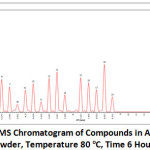 |
Figure 3: GC-MS Chromatogram of Compounds in Aloe Vera Peel Powder, Temperature 80 oC, Time 6 Hours. |
Phenolate Compounds
Phenolate compounds detected at 60oC temperature within 6 hours The dominant compound contained in aloe vera pell powder is generally classified as monoterpenoid which has high antioxidant properties. One of which is included is a phenol compound. The results of the detection of phenol compounds using HPLC chromatograms are presented in Figure 4 and Table 2. In Figure 4, there are 9 types of phenol compounds identified in aloe vera peel powder and 9 of these compounds are presented in Table 2. Nine types of phenol compounds were detected based on their retention time in succession, namely: Catechol, Pyrogallol, Salicylic, Protocatechuic acid, β-Coumaric acid, Gallic acid, Caffeic acid, Ferrulic acid and Cholorogenic acid, but there were three dominant compounds namely: Caffeic acid 734.49 (µg/g) peak 7, β-Coumaric acid 605.43 (µg/g) peak 5 and Pyrogallol 513.44 (µg/g) peak 2.
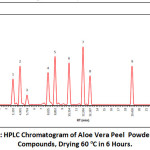 |
Figure 4: HPLC Chromatogram of Aloe Vera Peel Powder Phenol Compounds, Drying 60 oC in 6 Hours. |
Phenolate Compounds Detected at 70oC Temperature within 6 Hours
The results of the detection of phenol compounds using HPLC chromatograms are presented in Figure 5 and Table 2. Nine types of phenol compounds detected based on their retention time are Catechol, Pyrogallol, Salicylic, Protocatechuic acid, β-Coumaric acid, Gallic acid, Caffeic acid, Ferrulic acid and Cholorogenic acid, but there are three dominant compounds: Caffeic acid 664.00 (µg / g) peak 7, β-Coumaric acid 547.33 (µg/g) peak 5 and Pyrogallol 464.12 (µg/g) peak 2.
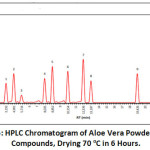 |
Figure 5: HPLC Chromatogram of Aloe Vera Powder Phenol Compounds, Drying 70 oC in 6 Hours. |
Phenolate Compounds Detected at 80oC Temperature within 6 Hours
The results of the detection of phenol compounds using HPLC chromatograms are presented in Figure 6 and Table 2. In Figure 6 there are 9 types of phenol compounds The results of the detection of phenol compounds using HPLC chromatograms are presented in Figure 6 and Table 2. In Figure 6 there are 9 types of phenol compounds identified in the powdered powder of the aloe vera peel and 9 of these compounds are presented in Table 2.
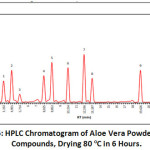 |
Figure 6: HPLC Chromatogram of Aloe Vera Powder Phenol Compounds, Drying 80 oC in 6 Hours. |
Nine types of phenol compounds detected based on retention time are Catechol, Pyrogallol, Salicylic, Protocatechuic acid, β-Coumaric acid, Gallic acid, Caffeic acid, Ferrulic acid and Cholorogenic acid, There are three dominant compounds Caffeic acid 867.85 (µg/g) peak 7th, β-Coumaric acid 715.37 (µg/g) peak 5 and Pyrogallol 606.76 (µg/g) peak 2. Thus the compound detected from the HPLC chromatogram of aloe vera pell powder with different drying temperatures produced the same type of dominant compound but had different percentage namely: Caffeic acid, β-Coumaric acid and Pyrogallol. Caffeic acid according to Laranjinha, 10 had been shown to have a protective effect on α-tocopherol in low-density lipoprotein (LDL).
β-Coumaric acid is a phenol compound that has strong antioxidant properties and according to Salameh et al. 11 this acid is unstable at high temperatures. Campos, Couto and Hogg 12. Some phenylpropanoid compounds including caffeic acid, p-coumaric acid and ferulic acid, are able to provide inhibition of bacterial growth, including E. coli, Staphylococcus aureus, Bacillus cereus, Listeria monocytogenes and some yeast. Pyrogallol according to Furuno, Akasako and Sugihara 13 has antioxidant activity and according to Lima 14 is a compound that has antibacterial activity.
Cell Microstructure
Aloe vera peel powder added with maltodextrin was then analyzed by cell microstructure using Scanning Electron Micoroscopy (SEM), which was carried out at magnifications of 1000 and 5000 times. Cell microstructure analysis was performed on aloe vera peel powder with maltodextrin which was dried at 60oC for 6 hours because it was the best treatment process based on the test of volatile components and phenol compounds. Fig 7. Shows the microstructure of aloe vera powder which was dried at 60oC for 6 hours. On the surface there were bubbles or spots that vary in size. This proved that micrographs with the addition of foaming agents, resulting in bubbles or spots caused by tween 80 as an agent that encourages foam forming can form cavities, making it easier to evaporate water during drying and the resulting powder has good solubility.
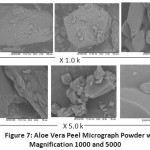 |
Figure 7: Aloe Vera Peel Micrograph Powder with Magnification 1000 and 5000. |
Conclusions
There are different amounts and types of compounds that appear in different drying treatments. Drying at 60 oC, 70 oC and 80 oC in 6 hours resulted in 21, 19 and 19 compounds respectively. The same three compounds from different temperature treatments were Menthone, 1- Anthrol and Anthranol. HPLC chromatogram of aloe vera peel powder also produced the same type of dominant compounds namely: Caffeic acid, β-Coumaric acid and Pyrogallol and SEM test with magnification of 500 and 1000 times showed small spots that indicate the presence of cavities and identified the resulting powder had good solubility.
Acknowledgments
We would like to thank DRPM DIKTI/KEMENRISTEKBRIN Indonesia for supplying fund to this research.
Conflict of Interest
The authors do not have any conflict of interest.
Funding Sources
DRPM DIKTI/KEMENRISTEKBRIN Indonesia with contract number 209/PL16.C1/PG/2020.
References
- Narsih, Kumalaningsih S., Wijana S., and Microencapsulation of natural antioxidant powder from Aloe vera (L.) peel using foam mat drying method. Int. Food Res. J. 2013; 20(1): 285-289.
- Pengseng N., Siripongvutikorn S., Usawakesmanee W. and Wattanachant S. Effect of thermal processing and protein nutrients on antioxidant activity of Tom-kha paste extract. As. J. Food Ag-Ind. 2010; 3(04): 389-399.
- Rajkumar P., Kailappan R., Viswanathan R. and Rghavan G.S.V. Drying characteristics of foamed alphonso mango pulp in a continuous type foam mat dryer. J. Food Eng. 2007; 79(4): 1452-1459.
CrossRef - Kudra T. and Ratti C. Process and energy optimazition in drying of foamed materials. Journal “Transactions of the TSTU”. 2008;14 (4): 812-819.
- Peana A.T., D’Aquila P. S., Panin F., Serra G., Pippia P., and Maretti M. D. L. Anti-inflammatory activity of linalool and linalyl acetate constituents of essential oils. 2002; 9: 721-726.
CrossRef - Prateeksha, Yusuf M.A.Y., Singh B.N., Sudheer S., Kharwar R.N., Siddiqui S., Abdel-Azeem A.M., Fraceto L.F., Dashora K. and Gupta V.K. Chrysophanol: A Natural Anthraquinone with Multifaceted Biotherapeutic Potential. Biomolecule 2019: 9(68): 1-24.
CrossRef - Doughari J.H., Ndakidemi P.A., Human I.S., Benade S. Antioxidant , antimicrobial and antiverotoxic potentials of extracts of Curtisia dentata. J. Ethnopharmacol. 2012; 141: 1041–1050.
CrossRef - Hamed M.M., Refahy L.A., Abdel-Aziz M.S. Evaluation of Antimicrobial Activity of Some Compounds Isolated from Rhamnus cathartica Oriental. J. Chem. 2015; 31: 1133–1140.
CrossRef - Iscan G., Kirimer N., Kürkcüoglu M.N,, Baser H,C,, Demirci F. Antimicrobial screening of Mentha piperita essential oils. J. Agric. Food Chem. 2002; 50(14): 3943-3946.
CrossRef - Laranjinha J., Vierira O., Almeida L. and Madeira V. Inhibition of metmyoglobin/H2O2-dependent low density lipoprotein lipid peroxidation by naturally occurring phenolic acids. Biochem. Pharmacol. 1996; 51: 395–402.
CrossRef - Salameh D., Brandam C., Medawar W., Lteif R., and StrehaianoP. Highlight on the problems generated by p-coumaric acid 2008.
CrossRef - Campos F. M., Couto J. A. and Hogg T. A. Infuence of phenolic acids on growth and inactivation of Oenococcusoeni and Lactobacillus hilgardii, J. Appl. Microbiol. 2003; 94: 167–174.
CrossRef - Furuno K., Akasako T. and Sugihara N. The contribution of the pyrogallol moiety to the superoxide radical scavenging activity of flavonoids. Pharm. Bull. 2002; 25: 19–23.
CrossRef - Lima V.N., Oliveira-Tintino C.D., Santos E.S., Morais L.P., Tintino S.R., Freitas T.S., Geraldo Y.S., Pereira R.L., Cruz R.P., Menezes I.R. and Coutinho H.D. Antimicrobial and enhancement of the antibiotic activity by phenolic compounds: Gallic acid, caffeic acid and pyrogallol. Microb. Pathogenesis. 2016; 99: 56-61.
CrossRef

This work is licensed under a Creative Commons Attribution 4.0 International License.


